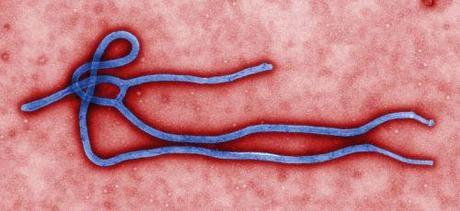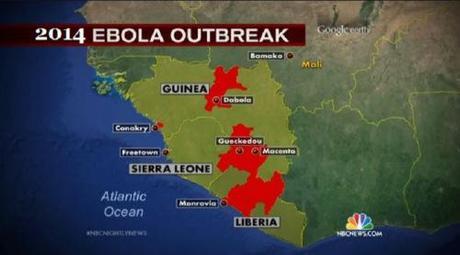 Ebola virus
Ebola virus
Ebola is one of the world’s deadliest viruses with a high fatality rate of 60 to as high as 90%.
There is no vaccine. No cure.
First identified in 1976 in the sub-Saharan jungles of Zaire and the Sudan, Ebola was transmitted to humans via the blood or bodily fluids of an infected fruit bat or monkey.
Symptoms typical of a viral infection begin 2 days to 3 weeks after contacting the virus — those of fever, throat and muscle pains, and headaches. Then it gets worse, with nausea, vomiting, diarrhea, and decreased functioning of the liver and kidneys. Then it gets even worse. The infected starts hemorrhaging or bleeding from the body’s mucous membranes — mouth (gums), nose, gastrointestinal tract, and vagina.

As of April 10, 157 suspected and confirmed cases and 101 deaths have been reported in Guinea, 22 suspected cases in Liberia including 14 deaths, 8 suspected cases in Sierra Leone including 6 deaths, and 1 suspected case in Mali.
In the past, an Ebola outbreak was quickly contained because lack of roads and transportation in rural Africa helped to quarantine the infection. But Richard Engel reports for NBC News, April 14, 2014, that now, for the first time since the deadly virus first appeared 38 years ago, Ebola has jumped from the jungle to an urban area — Conakry, the capital of Guinea, with a population of 2 million.
Dr. Jagatic described it as the biggest known Ebola outbreak an urban area: “It’s probably one of the more complicated outbreaks because it is occurring in a very densely-populated urban area, unlike previous outbreaks.”
Guinea is trying to contain the virus by prohibiting passengers with flu like symptoms — fever, diarrhea, or joint pain — from boarding plane flights.
Health officials do not expect the virus to go global. Dr. Anthony Fauci of the U.S. National Institutes of Health says, by its methods of transmission, it’s “very unlikely” that Ebola will spread to the United States.
Human-to-human transmission occurs via direct contact with blood or bodily fluids (from diarrhea or vomiting) from an infected person, or by contact with contaminated medical equipment such as needles. Since the virus continues to live inside a dead person, transmission can also occur via embalming an infected dead person. Men who survive may be able to transmit the disease sexually via sperm for nearly 2 months.
In late 2012, Canadian scientists discovered that the deadliest form of the virus could be transmitted by air between species, from pigs to monkeys without any direct contact between them, leading to fears that airborne transmission could be contributing to the wider spread of the disease in parts of Africa.
Some scientists believe that the Plague of Athens, which wiped out about a third of its inhabitants during the Peloponnesian War (431-404 B.C.), may have been caused by Ebola.
Given the lethal nature of Ebola, and since no approved vaccine or treatment is available, it is classified as a biosafety level 4 agent, as well as a Category A bioterrorism agent by the Centers for Disease Control and Prevention. It has the potential to be weaponized for use in biological warfare.
~Eowyn

